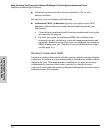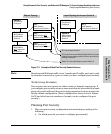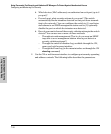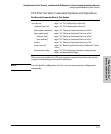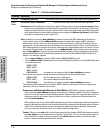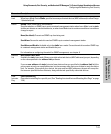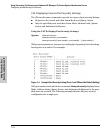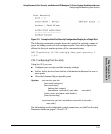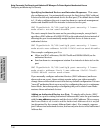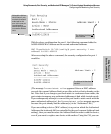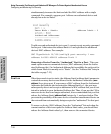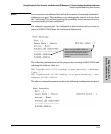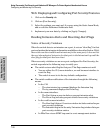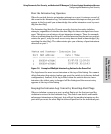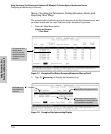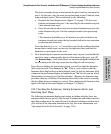
7-16
Using Passwords, Port Security, and Authorized IP Managers To Protect Against Unauthorized Access
Configuring and Monitoring Port Security
Using Passwords, Port
Security, and Authorized IP
Specifying Authorized Devices and Intrusion Responses. This exam-
ple configures port 1 to automatically accept the first device (MAC address)
it detects as the only authorized device for that port. (The default device limit
is 1.) It also configures the port to send an alarm to a network management
station and disable itself if an intruder is detected on the port.
SMC TigerSwitch 10/100(config)# port-security 1 learn-
mode static action send-disable
The next example does the same as the preceding example, except that it
specifies a MAC address of 0c0090-123456 as the authorized device instead of
allowing the port to automatically assign the first device it detects as an
authorized device.
SMC TigerSwitch 10/100(config)# port-security 1 learn-
mode static mac-address 0c0090-123456 action send-disable
This example configures port 5 to:
■ Allow two MAC addresses, 00c100-7fec00 and 0060b0-889e00, as the
authorized devices
■ Send an alarm to a management station if an intruder is detected on the
port
SMC TigerSwitch 10/100(config)# port-security 5 learn-
mode static address-limit 2 mac-address 00c100-7fec00
0060b0-889e00 action send-alarm
If you manually configure authorized devices (MAC addresses) and/or an
alarm action on a port, those settings remain unless you either manually
change them or the switch is reset to its factory-default configuration. You can
“turn off” authorized devices on a port by configuring the port to continuous
Learn Mode, but subsequently reconfiguring the port to static Learn Mode
restores those authorized devices.
Adding an Authorized Device to a Port. To simply add a device (MAC
address) to a port’s existing Authorized Addresses list, enter the port number
with the mac-address parameter and the device’s MAC address. This assumes
that Learn Mode is set to static and the Authorized Addresses list is not full
(as determined by the current Address Limit value). For example, suppose
port 2 allows two authorized devices, but has only one device in its Authorized
Address list:



